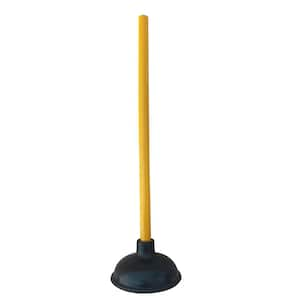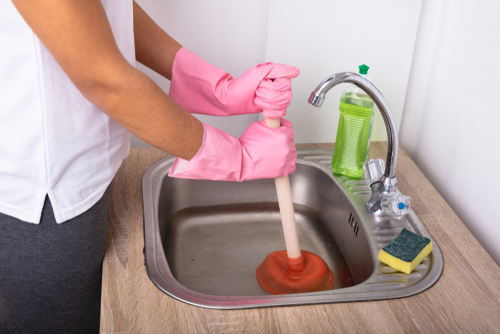Efficient Plungers and Drain Cleaners Strategies: Key Practices
Efficient Plungers and Drain Cleaners Strategies: Key Practices
Blog Article
Right here down the page you can locate more quality facts on the subject of Tips on How to Effectively Use a Plunger.

Introduction
Correct upkeep of house drains is necessary for protecting against blockages and ensuring smooth water circulation. Among the secret tools in every home owner's toolkit is the plunger, together with different drain cleaners developed to deal with stubborn clogs efficiently. This post checks out exactly how to utilize bettors and drainpipe cleaners successfully to maintain your drains flowing easily.
Area 1: Recognizing Plungers
Kinds of Plungers
There are several kinds of plungers offered, each developed for various types of drains pipes and clogs. The most usual kinds include cup plungers, flange plungers, and accordion bettors.
Exactly How Plungers Job
Bettors work on the concept of developing stress and suction to dislodge obstructions. When correctly applied over a drainpipe, they develop a vacuum cleaner that can take out particles or separate obstructions.
Picking the Right Plunger
Choosing the right bettor relies on the sort of drain and the nature of the clog. Mug plungers are optimal for sinks and tubs, while flange bettors are better suited for commodes because of their layout.
Typical Errors with Plungers
Staying clear of these errors ensures reliable plunging: inappropriate seal around the drainpipe, not enough pressure, and not clearing surrounding debris.
Area 2: Using Plungers Properly
Prep work
Prior to diving, make sure the plunger covers the drainpipe totally and creates a limited seal. Clear any type of noticeable particles around the drain opening.
Technique
Beginning with gentle diving movements to develop suction. Rise pressure slowly, utilizing a stable rhythm. Repeat as essential up until the drainpipe removes.
Troubleshooting Tips
If plunging does not function, try adjusting the seal, using petroleum jelly for a much better seal, or making use of a various kind of plunger.
Area 3: Recognizing Drainpipe Cleaning Company
Types of Drainpipe Cleansers
Drain pipes cleansers can be chemical or chemical. Chemical cleaners utilize solid chemicals to liquify clogs, while enzymatic cleaners make use of all-natural enzymes to break down organic matter.
Just How Drainpipe Cleansers Job
Chemical cleansers react with blockages to liquify them, while chemical cleansers break down natural products like hair and grease without harming pipelines.
Security Considerations
Constantly put on gloves and eye protection when making use of chemical drain cleaners. Make certain sufficient air flow and follow maker directions very carefully.
Eco-Friendly Alternatives
Think about using vinegar and cooking soft drink or enzyme-based cleaners for environment-friendly choices that are much safer for pipelines and the atmosphere.
Section 4: Utilizing Drain Cleaners Efficiently
Application Techniques
Pour chemical cleansers straight into the drain opening. Allow them to work for the advised time prior to flushing with hot water. Chemical cleaners should sit over night.
Preventative measures
Stay clear of blending different types of cleaners, as this can produce harmful fumes. Never utilize chemical cleansers together with a bettor, as spilling can happen.
Managing Persistent Blockages
For consistent blockages, think about using a plumbing serpent or calling a professional plumber to avoid damages to pipes.
Conclusion
Finally, recognizing exactly how to use plungers and drain cleansers effectively is necessary for keeping healthy and balanced pipes systems. By selecting the right tools and techniques, homeowners can deal with minor clogs and protect against significant pipes problems down the line.
How To Properly Use A Plumbing Snake To Clear Drains
When any drain clogs in our home arise, we tend to gravitate toward the plunger and little else. In cases where the plunger and its vacuum-created pressure are not able to clear clogs, many immediately move to harmful chemicals or simply call their plumber to fix the issue.
we’re happy to help with all drain cleaning needs and concerns. This includes informing you on a few other home remedies you may have at your disposal for minor to moderate clogs, one of which is the use of a plumbing snake. Many people have never used one of these before – let’s go over the steps to take when your drain clogs and you have a plumbing snake available.
Attempt Plunger Use
The first step here, as we noted above, should indeed be to grab your plunger when you notice a drain clog and attempt to resolve it this way. If you’re unsure how to use a particular type of plunger, our plumbers can answer any questions you have. If this doesn’t do the trick, however, you move on to the snake.
Locate And Prepare Snake
A plumbing snake is a metal or plastic device that’s generally about a quarter of an inch thick. It’s design with significant extensions, meant to reach down into your clogged drain and push the clog out. Snakes also contain drain augers that will latch onto and push stubborn blockages.
If your plunger doesn’t clear a clog, locate your snake and bring it to the drain in question. We also recommend keeping a bucket nearby to collect the clog once you pull it out, plus we’d advise wearing goggles and possibly protective gloves.
Feed Snake
Once you’re ready to go, feed the snake slowly down the drain, using the crank device it comes with to keep it moving until it finds the clog. Once this happens, much of the clog will be latched onto the coil so you can pull it out, while the rest will simply break up and flow downward.
Detach Debris
Remove the snake slowly from the drain, and once you’ve done so, pick off any debris that’s stuck to the coil. This is another area where wearing gloves is a must.
Flush Drain
Finally, take a few minutes to ensure the snake has done its job correctly. If you’ve been using it on a toilet, flush the toilet a couple times and make sure everything flows well. If you’ve used it on a different drain, flush it with some room temperature water.
https://www.mybuddytheplumber.com/blog/how-to-properly-use-a-plumbing-snake-to-clear-drains/

Application Techniques
Pour chemical cleansers straight into the drain opening. Allow them to work for the advised time prior to flushing with hot water. Chemical cleaners should sit over night.
Preventative measures
Stay clear of blending different types of cleaners, as this can produce harmful fumes. Never utilize chemical cleansers together with a bettor, as spilling can happen.
Managing Persistent Blockages
For consistent blockages, think about using a plumbing serpent or calling a professional plumber to avoid damages to pipes.
Conclusion
Finally, recognizing exactly how to use plungers and drain cleansers effectively is necessary for keeping healthy and balanced pipes systems. By selecting the right tools and techniques, homeowners can deal with minor clogs and protect against significant pipes problems down the line.
How To Properly Use A Plumbing Snake To Clear Drains
When any drain clogs in our home arise, we tend to gravitate toward the plunger and little else. In cases where the plunger and its vacuum-created pressure are not able to clear clogs, many immediately move to harmful chemicals or simply call their plumber to fix the issue.
we’re happy to help with all drain cleaning needs and concerns. This includes informing you on a few other home remedies you may have at your disposal for minor to moderate clogs, one of which is the use of a plumbing snake. Many people have never used one of these before – let’s go over the steps to take when your drain clogs and you have a plumbing snake available.
Attempt Plunger Use
The first step here, as we noted above, should indeed be to grab your plunger when you notice a drain clog and attempt to resolve it this way. If you’re unsure how to use a particular type of plunger, our plumbers can answer any questions you have. If this doesn’t do the trick, however, you move on to the snake.
Locate And Prepare Snake
A plumbing snake is a metal or plastic device that’s generally about a quarter of an inch thick. It’s design with significant extensions, meant to reach down into your clogged drain and push the clog out. Snakes also contain drain augers that will latch onto and push stubborn blockages.
If your plunger doesn’t clear a clog, locate your snake and bring it to the drain in question. We also recommend keeping a bucket nearby to collect the clog once you pull it out, plus we’d advise wearing goggles and possibly protective gloves.
Feed Snake
Once you’re ready to go, feed the snake slowly down the drain, using the crank device it comes with to keep it moving until it finds the clog. Once this happens, much of the clog will be latched onto the coil so you can pull it out, while the rest will simply break up and flow downward.
Detach Debris
Remove the snake slowly from the drain, and once you’ve done so, pick off any debris that’s stuck to the coil. This is another area where wearing gloves is a must.
Flush Drain
Finally, take a few minutes to ensure the snake has done its job correctly. If you’ve been using it on a toilet, flush the toilet a couple times and make sure everything flows well. If you’ve used it on a different drain, flush it with some room temperature water.
https://www.mybuddytheplumber.com/blog/how-to-properly-use-a-plumbing-snake-to-clear-drains/

I ran across that content on How to Unclog Your Sink with a Plunger while perusing the web. Sharing is caring. Helping others is fun. Thanks so much for taking the time to read it.
Call Today Report this page